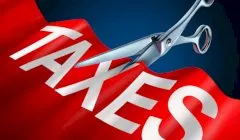Save
What the tax breaks in the budget actually mean for your savings
The government’s plans to flatten the tax brackets may not have the intended outcome for taxpayers and the economy, according to one tax expert.
What the tax breaks in the budget actually mean for your savings
The government’s plans to flatten the tax brackets may not have the intended outcome for taxpayers and the economy, according to one tax expert.

From 2024–25, the government has proposed just three marginal tax rates above the tax-free threshold: 19 per cent for those earning between $18,201 and $45,000; 30 per cent for incomes up to $200,000; and 45 per cent as the highest rate for incomes above $200,001.
While the government has already legislated to remove the 37 per cent tax bracket, the plan will see the current 32.5 per cent rate be pushed down to 30 per cent, and the top income threshold raised from $180,000 to $200,000.
Treasurer Josh Frydenberg said that the changes will mean 94 per cent of taxpayers will face a tax rate of 30 per cent or less.
Speaking to Nest Egg’s sister publication, Accountants Daily, the Tax Institute’s senior tax counsel, Professor Robert Deutsch, said that while at face value it would seem that someone on a $45,000 income would be paying the same rate of tax as a taxpayer on $200,000, it would in fact be about eight times less.

“If you look at the marginal rates and feed them into the calculation, on the Coalition’s projected tax rates, someone on $200,000 will pay almost eight times more in income tax than someone on $50,000.
“When someone on four times more income pays eight times more tax, you indeed have a progressive tax system.”
He added: “I quite like the simplicity of that and it makes it a bit more straightforward.
“What I do like about that is that it gives people a better incentive to earn more income up to that $200,000 level.
“Economists will argue whether that incentive is real or just perceived, but I think it is good thing that somebody earning $60,000 or $70,000 and gets a 10 per cent pay rise doesn’t slip into a higher tax bracket.”
BDO national tax director Lance Cunningham said that while the plan looked good upfront, it would be a considerably long time before taxpayers would enjoy the flatter tax rates, especially in the current political and economic climate.
“It’s not until 2024, so it’s a bit on the never never — if you wait long enough, you might get something out of this,” Mr Cunningham said.

Tax saving
Navigating tax laws for capital gains in 2023
The landscape of Australian tax laws surrounding capital gains is ever-changing, with 2023 being no exception. Read more

Tax saving
What you need to know about the tax implications of crypto
One million Aussies are now invested in crypto, but many have not thought about how these investments will affect them at tax time. Read more

Tax saving
Welfare overhaul could give recipients a leg-up
Australia’s Centrelink recipients who’ve been doing it tough are in for a potentially easier time if the federal government pursues ambitious reforms that could provide sturdier safety nets. Read more

Tax saving
Students should think twice before tapping into their super
Former students might want to think carefully before they look to take advantage of the federal government’s biggest first home buyer incentive. Read more

Tax saving
Advocates call for an end to tax cuts
Social services sector advocates have warned that further tax cuts may make solving Australia’s biggest challenges much harder. Read more

Tax saving
ATO and AUSTRAC may gain new phone-tapping powers
A proposed update to electronic surveillance legislation could see the ATO armed with new powers that would allow the agency to bug phones and intercept online communications. Read more

Tax saving
Over 2m Aussies asked the TPB for help during the last year
As the economy recovers, Australia’s tax regulator says it’s planning to put unregistered practitioners under the microscope. Read more

Tax saving
Will you pay higher taxes due to bracket creep?
Bracket creep will see Australians paying more tax on average, unless further cuts are introduced in the future. Read more

Tax saving
Navigating tax laws for capital gains in 2023
The landscape of Australian tax laws surrounding capital gains is ever-changing, with 2023 being no exception. Read more

Tax saving
What you need to know about the tax implications of crypto
One million Aussies are now invested in crypto, but many have not thought about how these investments will affect them at tax time. Read more

Tax saving
Welfare overhaul could give recipients a leg-up
Australia’s Centrelink recipients who’ve been doing it tough are in for a potentially easier time if the federal government pursues ambitious reforms that could provide sturdier safety nets. Read more

Tax saving
Students should think twice before tapping into their super
Former students might want to think carefully before they look to take advantage of the federal government’s biggest first home buyer incentive. Read more

Tax saving
Advocates call for an end to tax cuts
Social services sector advocates have warned that further tax cuts may make solving Australia’s biggest challenges much harder. Read more

Tax saving
ATO and AUSTRAC may gain new phone-tapping powers
A proposed update to electronic surveillance legislation could see the ATO armed with new powers that would allow the agency to bug phones and intercept online communications. Read more

Tax saving
Over 2m Aussies asked the TPB for help during the last year
As the economy recovers, Australia’s tax regulator says it’s planning to put unregistered practitioners under the microscope. Read more

Tax saving
Will you pay higher taxes due to bracket creep?
Bracket creep will see Australians paying more tax on average, unless further cuts are introduced in the future. Read more















